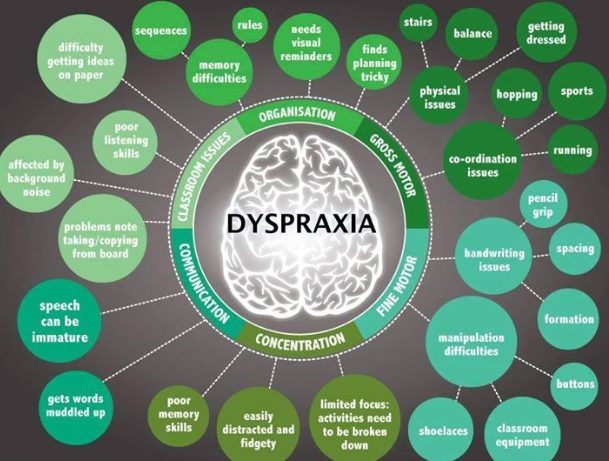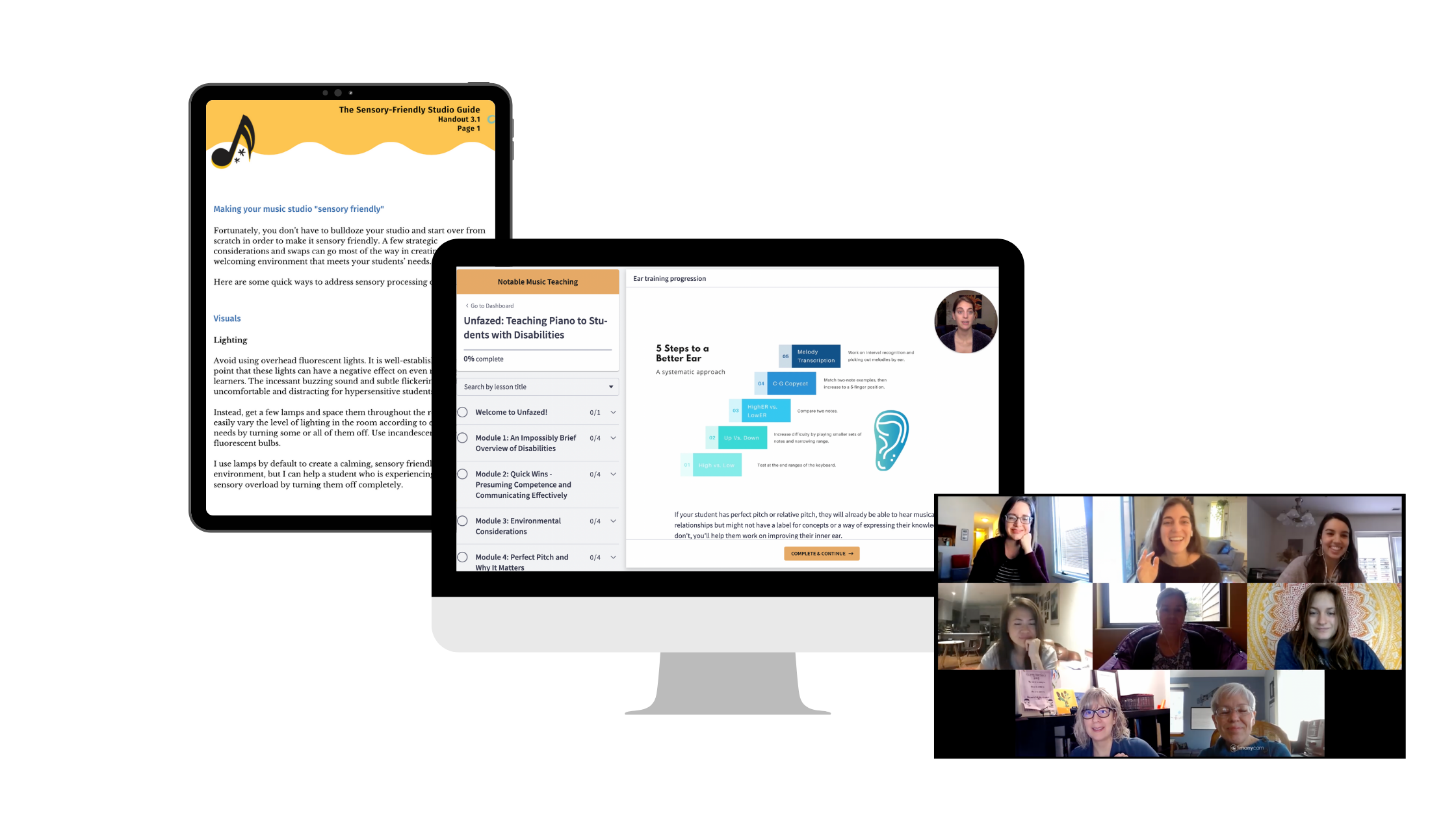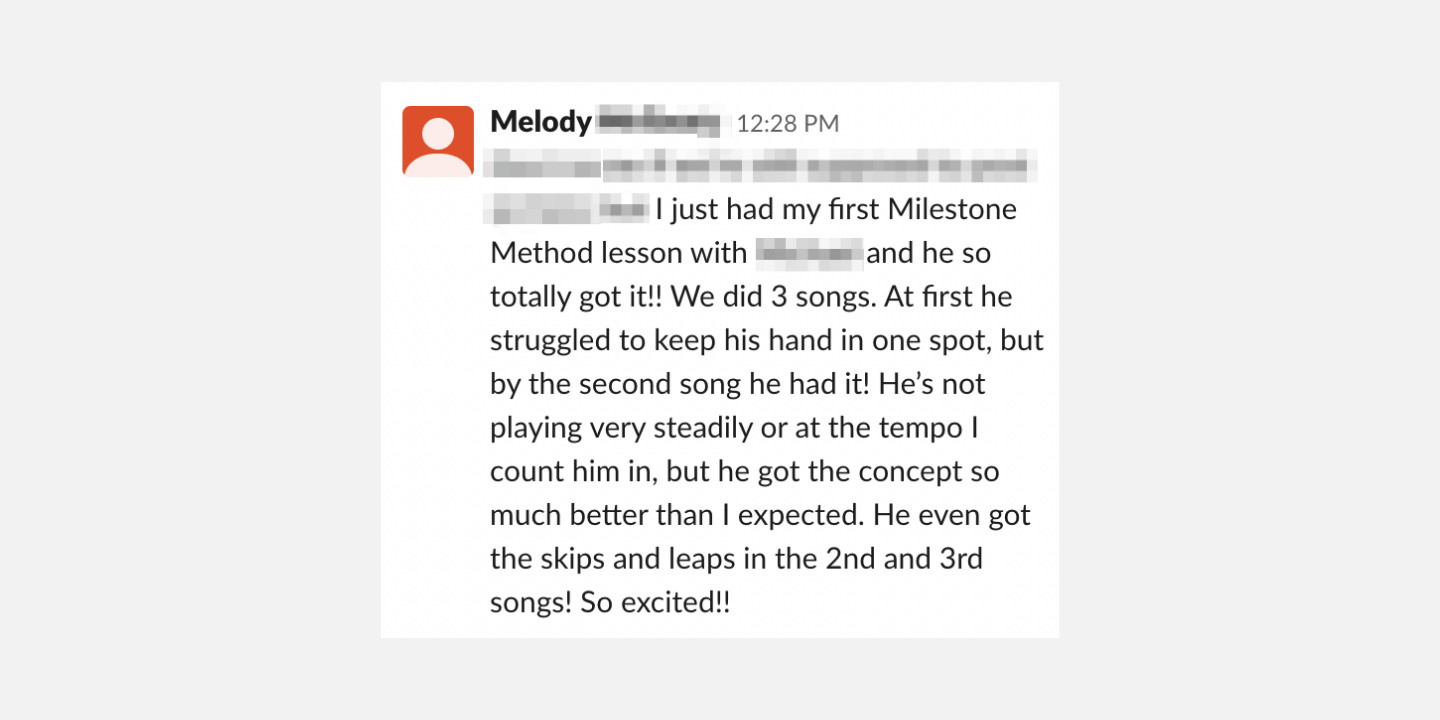Unfazed: Teaching Piano
to Students with Disabilities
Transform your teaching so you can feel CONFIDENT taking on any student with disabilities.
What if you could open the door to the world of music for students who have been closed out?
Does this sound like you?
Hi, I'm Selena

I’m a lifelong pianist, piano teacher since 2008, teacher trainer, studio owner, author of the Milestone Method, and the founder of Notable. I teach piano full-time in the SF Bay Area, California, in my studio of 50+ students, and almost all of them have disabilities or special needs.
Like you, I stumbled upon this niche by happy accident. Being a lifelong learner, I was captivated by the challenge of figuring out how to teach this growing population of students who were either puzzled or were largely ignored by modern pedagogy. I was also, at times, completely stumped.
After years of trial and error with countless workshops, courses, forums, methods, and Pinterest experiments, I developed a system for effectively teaching students with special needs. Since I’m only one person, I felt compelled to share what I know with as many teachers as possible so we can reach the millions of potential students who still haven’t been given the opportunity to learn music.
Why should you start from scratch, when I can pass on proven methods that will make your life easier and fill your studio with smiling students?
IT IS MY MISSION TO DEMYSTIFY TEACHING STUDENTS WITH SPECIAL NEEDS AND SAVE YOU YEARS OF TRIAL AND ERROR BY GIVING YOU THE TOOLS AND ROAD MAPS YOU NEED, RIGHT NOW.

Tim Topham - Creator of TopMusicPro
"When music teachers started asking me for resources about teaching special needs students that I could share in my membership, I knew exactly who to ask: Selena Pistoresi. Already well known in the industry, Selena blew us away with her knowledge and skills in this area; skills that far surpass anything I could have shared. Always happy to share her teaching in action, Selena recorded heaps of teaching videos, both in-person and online, showing exactly how to work with a variety of students. These have had by far the biggest impact on our members; seeing an experienced teacher in action working directly with her students."
You don't need to color-code everything or only teach by rote.
I used to think that my students couldn’t understand me.
I’d show them middle C on the page, then show them middle C on the piano. They might remember for a minute or even for a whole lesson, but they'd seem to forget by the following week.
I spent countless lessons going over finger numbers again and again.
I used flashcards for note identification, but accuracy was at best 50/50.
Some students couldn’t even seem to remember how to identify C on the piano from week to week. I’d ask them to play black keys, but they would play white keys or just bang around randomly.
I was so frustrated with both myself and my students. Are they not even listening to me?
Do I need to break down each concept even MORE than I already am and drill it endlessly in every lesson?
The problem wasn't that my students couldn't learn.
I was going about it all wrong...
It turns out that many of my students had some degree of dyspraxia.
“Dyspraxia” covers a range of disorders that affect one’s ability to plan, process, and perform motor tasks. In other words, people with dyspraxia have trouble getting the body to do what they want, when they want.
Being a disorder of movement, it can affect things like whole body coordination (like walking, jumping, or catching a ball), fine motor movements (like using scissors or playing the piano), and spatial awareness.
Perhaps less obviously, it can also affect speech. After all, speech is ultimately a complex motor function.
BUT... dyspraxia doesn’t affect intelligence. It can cause problems with perception and concentration, and it can cause speech to be jumbled or even impossible for some, but it does not affect intellectual ability.

Of course, not all of my students had dyspraxia. But this realization opened me up to the idea that many students were being underestimated and not being given a chance to succeed.
I realized that I needed to trust that my students could understand what I was telling them (given that it was appropriate for their age and level), even if they couldn’t execute it or demonstrate their understanding quite yet.
I needed to presume competence.
Once I learned to relentlessly presume competence in my students, I could focus on addressing dyspraxia and whatever other physical, emotional, or executive functioning challenges that prevented them from learning piano in “traditional” ways.
I could stop boring them to death with endless repetitions and insulting their intelligence by color-coding everything or talking in a loud baby voice.
I could respect them as intelligent individuals, and they could respect me as someone who “gets” them.
Most importantly, I could figure out concrete and practical ways to get their hands playing the piano.
These methods aren't just for students with dyspraxia.
They're not exclusive to a specific diagnosis like autism, ADHD, Down Syndrome, or something else.
The information in this course can be applied to a huge range of needs, abilities, and levels.

Rosemarie Penner - Studio Owner and Creator of The Unfinished Lesson
"Selena is an expert in working with neurodiverse students & families. Her student-centred philosophy ensures that teachers assume competency, so students continually progress even if it’s not a typical trajectory. I especially enjoyed all the activity ideas she provided (both on & off the bench) plus how to adapt them to online lessons. Throughout the course, Selena was committed to making sure each teacher was supported & our (many) questions answered. Whether you trained as a “special needs” teacher, are new to teaching neurodiverse students or somewhere in between, Unfazed has ideas, strategies & activities to bring to the studio."
IMAGINE HOW IT WOULD FEEL TO ...
... ALL of that is possible.
INTRODUCING UNFAZED:
The self-paced course that gives teachers the skills, confidence, and game plan to take on any student with disabilities.

What's included?
Everything above is yours for $399 or
three monthly payments of $149.
- 1Show a product image: it's always a good idea to have a visual representation of your product. It makes it more tangible and more "real" in your reader's mind.
- 2The power of the points list: use this list to emphasize the most important benefits of your product.
- 3Benefits over features: for every feature your product has, try to translate it into a benefit (i.e. a positive end-result your customer will get).
Product Name
Product Name
Testimonials


Get Started Now
Here we have a highly attractive purchase section. We display another paragraph of text, which is a strong call to action to your readers. In addition, we have a product image, unmissable large button and some guarantee and safety symbols.


100% Satisfaction Guaranteed

Secure Payment
Not sure if this is the right course for you?

100% Satisfaction Guarantee
You are fully protected by our 100% Satisfaction-Guarantee. If you don't get [a specific benefit that your product promises] by [a specific span of time in which you guarantee your product to yield results], just let us know and we'll send you a prompt refund.
Frequently Asked Questions
How long does it take to complete the course?
I've never taught students with disabilities or special needs before. Is it really difficult?
How long will I have access to the course material?
What if I already teach students with special needs? Will I still get something from this course?
Do I have to change everything about my teaching?
P.S.: Welcome to the post script section of the page. You can have one or several of these. This part is all about loss aversion. Here is where you can remind your reader that if they don't jump on this opportunity right now they will be missing out.
After the post scripts, use the link below to link to your purchase section or the checkout page.
Copyright -